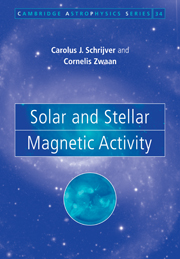Book contents
- Frontmatter
- Contents
- Preface
- 1 Introduction: solar features and terminology
- 2 Stellar structure
- 3 Solar differential rotation and meridional flow
- 4 Solar magnetic structure
- 5 Solar magnetic configurations
- 6 Global properties of the solar magnetic field
- 7 The solar dynamo
- 8 The solar outer atmosphere
- 9 Stellar outer atmospheres
- 10 Mechanisms of atmospheric heating
- 11 Activity and stellar properties
- 12 Stellar magnetic phenomena
- 13 Activity and rotation on evolutionary time scales
- 14 Activity in binary stars
- 15 Propositions on stellar dynamos
- Appendix I Unit conversions
- Bibliography
- Index
10 - Mechanisms of atmospheric heating
Published online by Cambridge University Press: 14 August 2009
- Frontmatter
- Contents
- Preface
- 1 Introduction: solar features and terminology
- 2 Stellar structure
- 3 Solar differential rotation and meridional flow
- 4 Solar magnetic structure
- 5 Solar magnetic configurations
- 6 Global properties of the solar magnetic field
- 7 The solar dynamo
- 8 The solar outer atmosphere
- 9 Stellar outer atmospheres
- 10 Mechanisms of atmospheric heating
- 11 Activity and stellar properties
- 12 Stellar magnetic phenomena
- 13 Activity and rotation on evolutionary time scales
- 14 Activity in binary stars
- 15 Propositions on stellar dynamos
- Appendix I Unit conversions
- Bibliography
- Index
Summary
After our discussion of the observed radiative emissions from solar and stellar outer atmospheres, we now turn to the mechanisms heating the outer-atmospheric domains to a temperature that even in apparently quiescent conditions is up to 3 orders of magnitude higher than that of the photosphere. Over the years, a multitude of mechanisms has been proposed to transport energy from the stellar interior into the outer atmosphere and to dissipate it there (see the compilations by Narain and Ulmschneider, 1990, 1996, and the summary in Table 10.1). It has become clear that the real question is no longer how the atmosphere can be heated, but which mechanisms dominate under specific conditions. The problem of outer-atmospheric heating can be separated into two parts: (a) what is the source of the energy, and (b) how is it transported and dissipated? Although at first sight the second part seems to be separable into the problems of transport and dissipation, this is not always the case, because some mechanisms intricately link these two processes through cascades or critical self-regulation, as we mention below.
Our discussion concentrates on coronal heating, with a substantial bias to current-based mechanisms. Space limitations do not allow an in-depth discussion of the many distinct wave-heating processes. Chromospheric heating follows similar principles as coronal heating, but the added complexity of radiative transfer and nonforce-free fields complicate studies in this area. In contrast, the larger viscosity and resistivity of the chromosphere make it easier to dissipate both currents and waves.
- Type
- Chapter
- Information
- Solar and Stellar Magnetic Activity , pp. 266 - 276Publisher: Cambridge University PressPrint publication year: 2000



